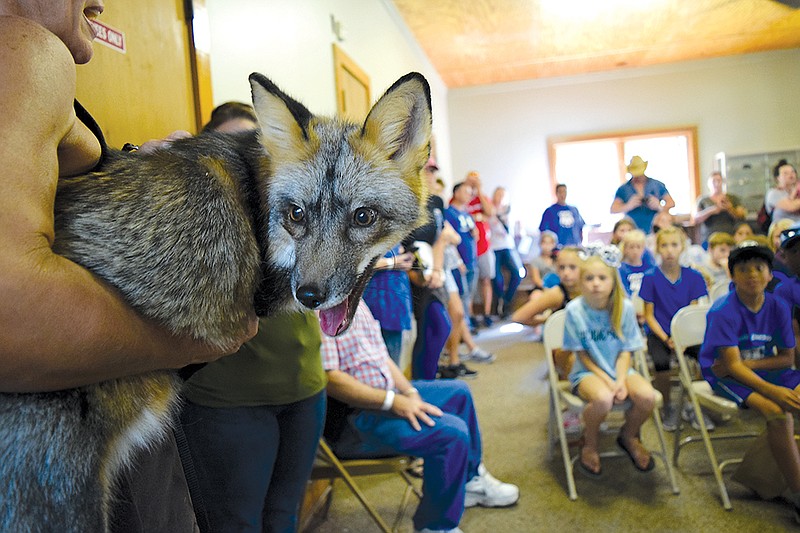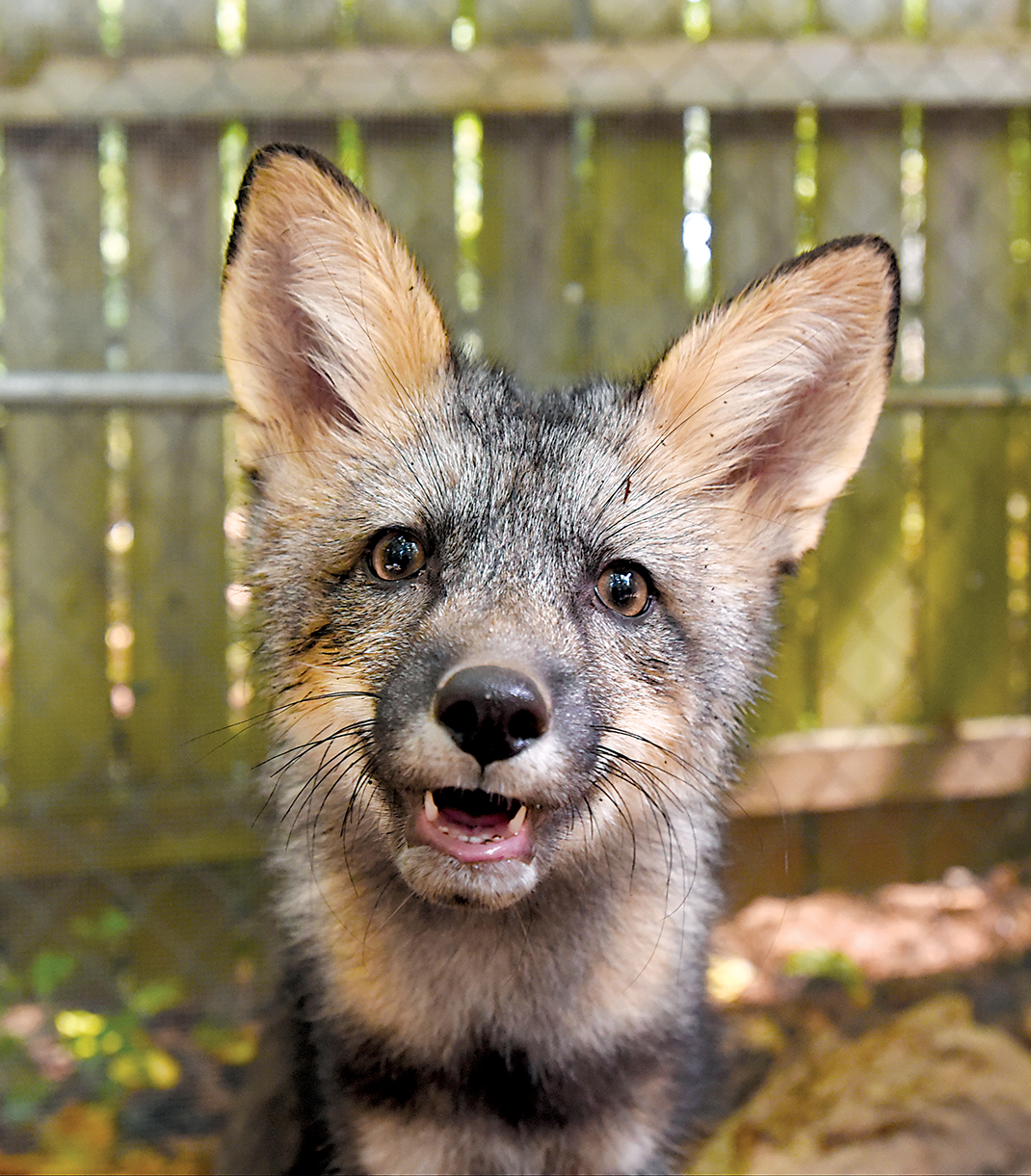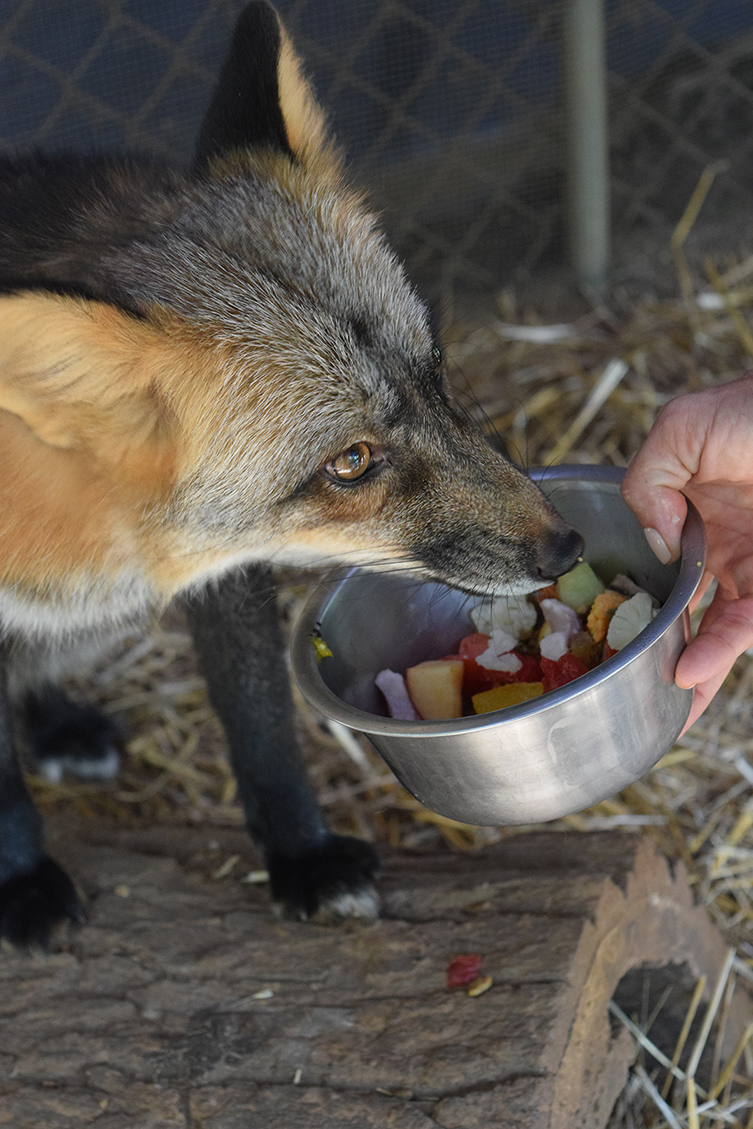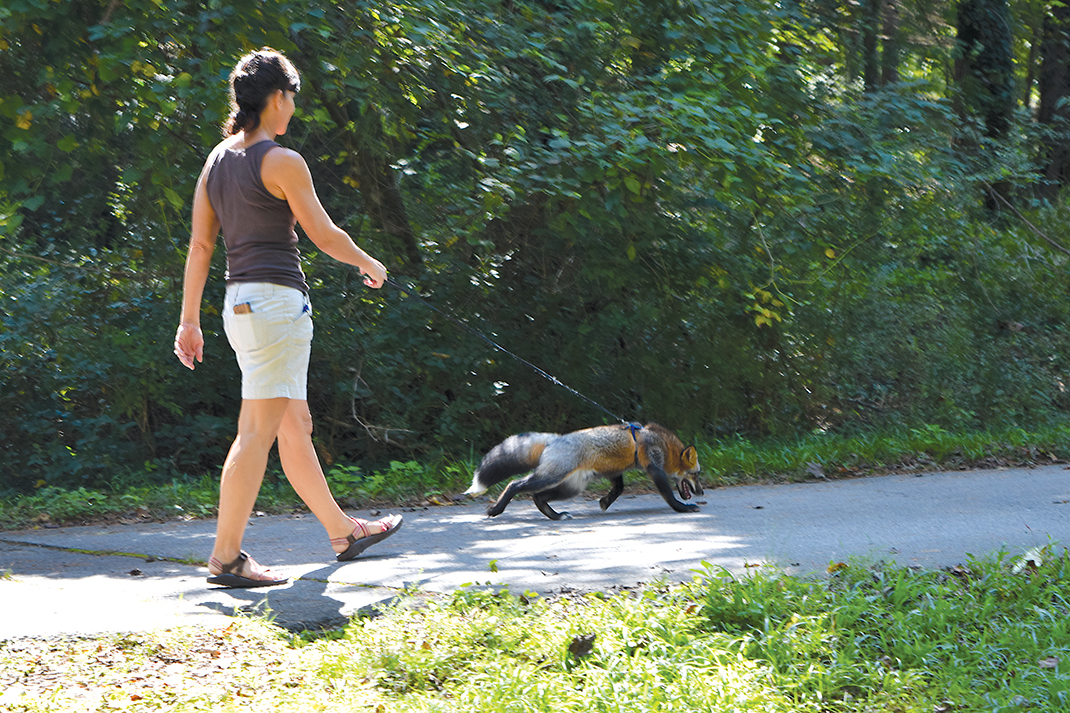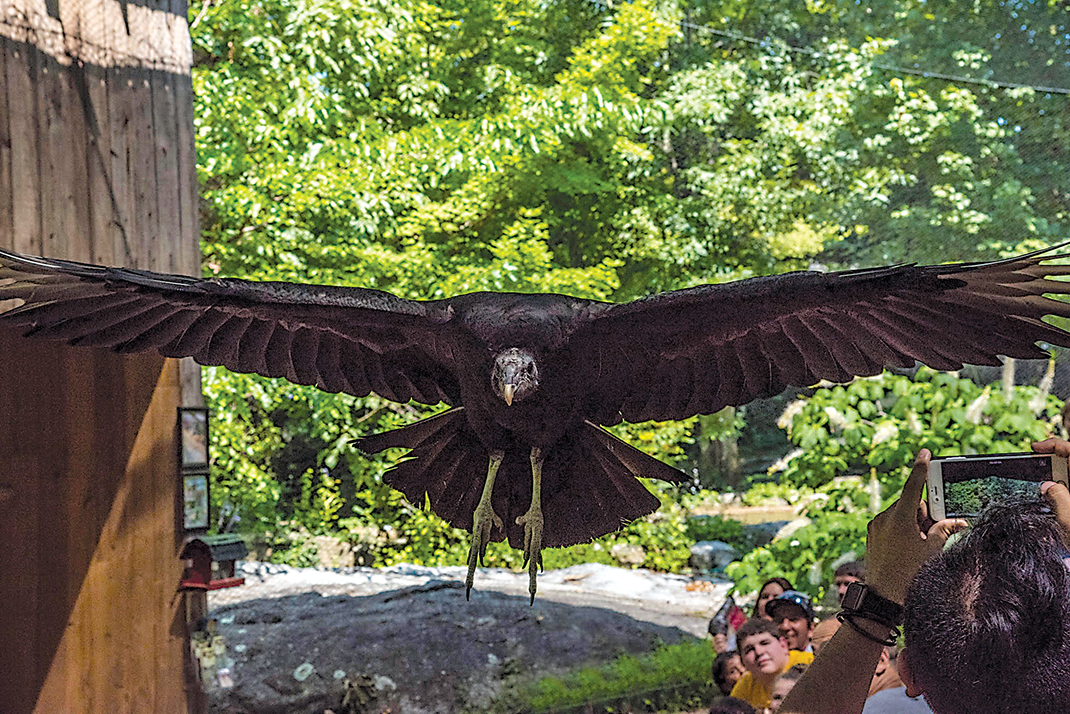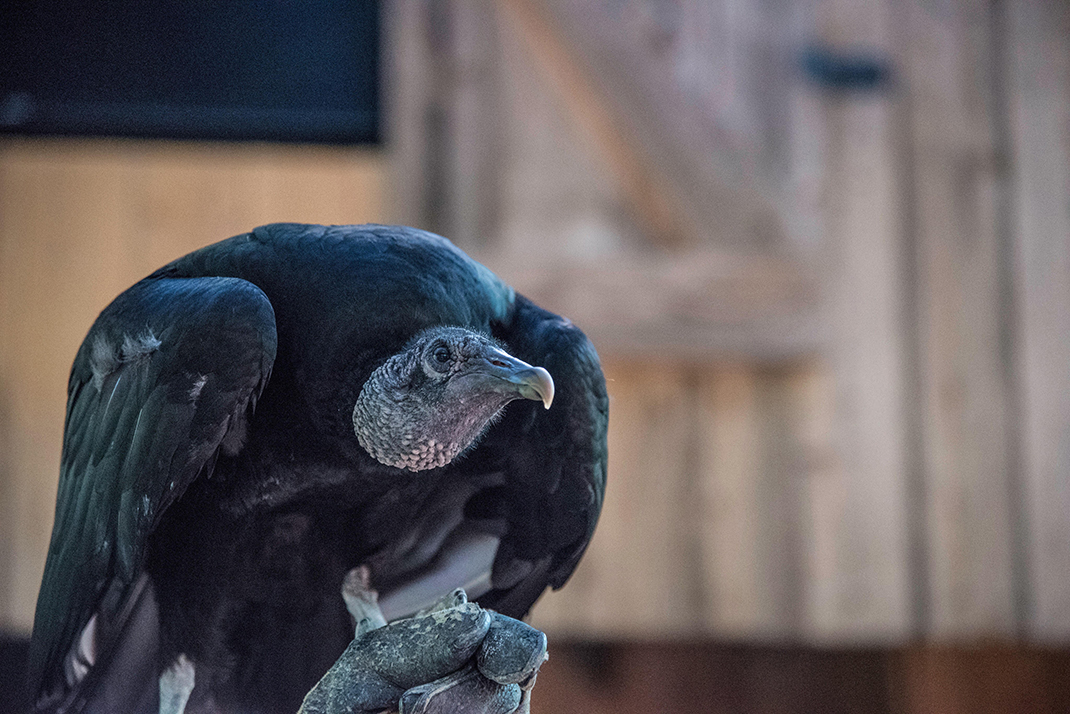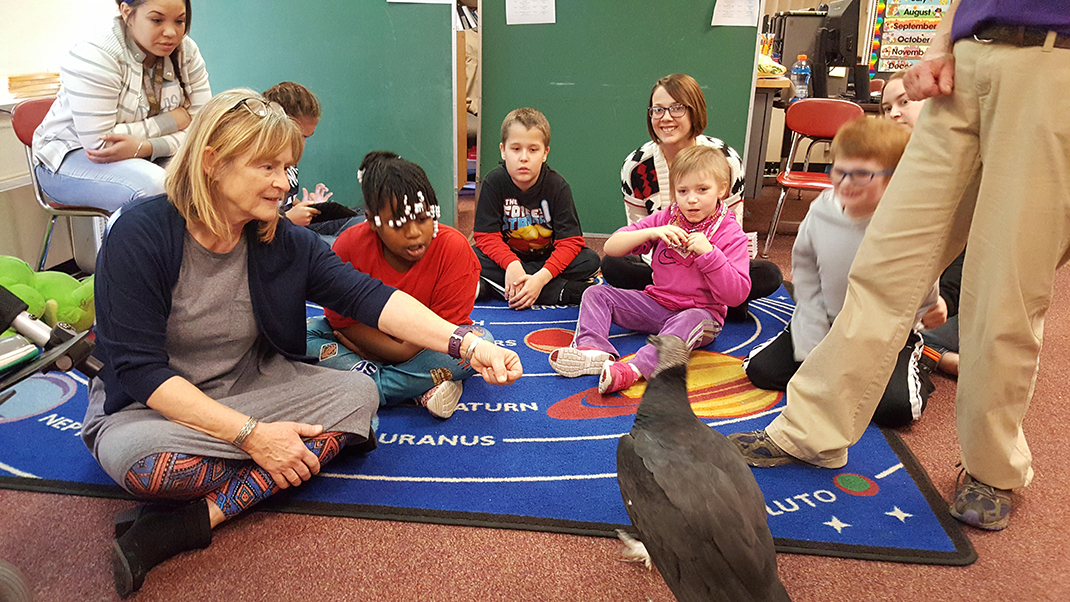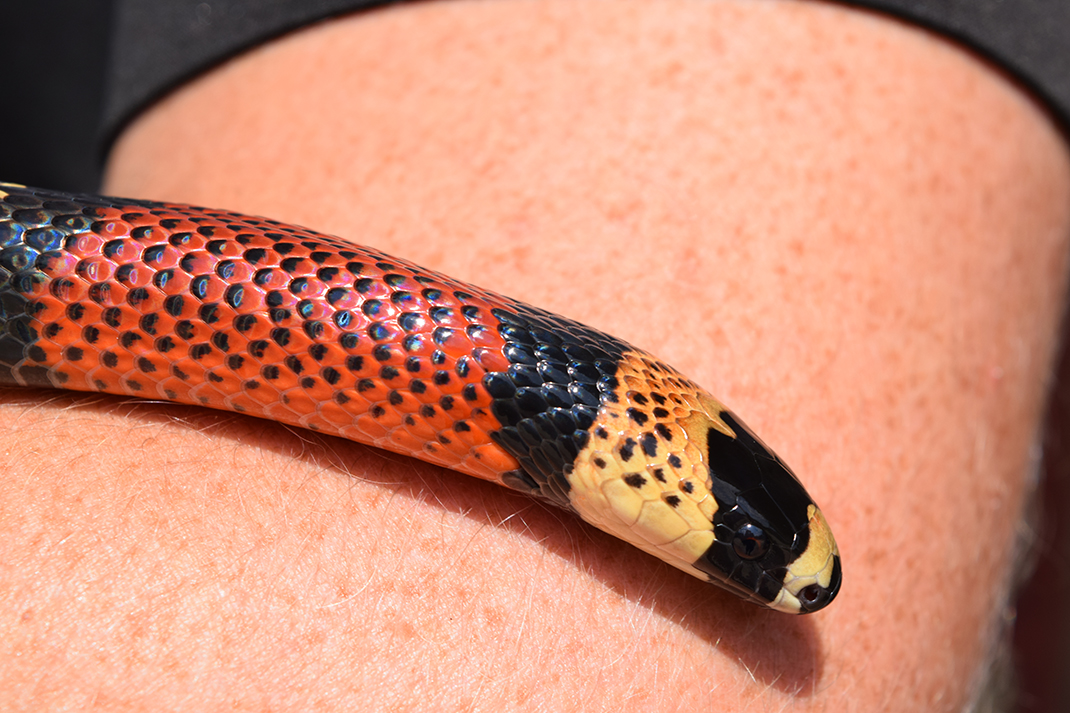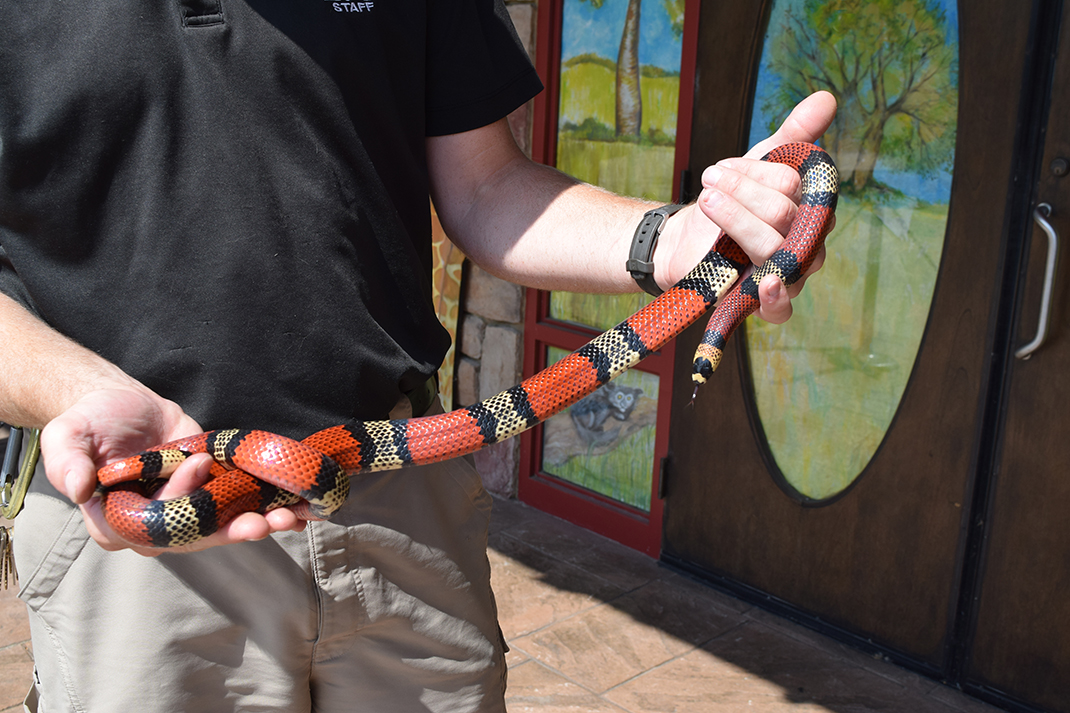These ambassadors do not reside in heavily guarded embassies or dine on danishes for breakfast. Rather, they live in hay-strewn enclosures and eat dead mice. Though Todd is an exception. Every morning, he is hand-fed a scrambled egg.
"Todd is a wild animal and he'll never be totally calm, but this helps keep him more social," handler Tish Gailmard says as she passes warm hunks of egg into the red fox's mouth.
Todd may be a fox - and not a jet-setting U.S. diplomat - but his role at Reflection Riding Arboretum & Nature Center as a species ambassador is equally important.
A species ambassador, also called an education animal, is a wild animal that, due to injury or human imprinting, cannot return to the forest - and has been lucky enough to find refuge in a facility like Reflection Riding. There, the animal will live as a spokesperson, so to speak, educating the public on the respective animal's ecological importance.
With his red coat, perked ears and enormously fluffy white-tipped tail, Todd easily charms his audiences. Other ambassadors, however, must work harder to win hearts. Take Cayce the black vulture or Gincy the Honduran milk snake, two of Chattanooga's seemingly less cuddly animal educators.
But who has time to be cuddly when the task of representing an entire species is at hand? To learn more about the important work these animals do, we spent some time at their respective rescue centers: Reflection Riding, Wings to Soar and the Chattanooga Zoo.
Todd the Red Fox
» Age: 17 months » Lives at: Reflection Riding Arboretum & Nature Center
Todd the fox has mixed feelings about his harness and leash. On one hand, putting them on means getting to go for a walk, which Todd loves. Every afternoon, Gailmard fits the strappy blue nylon over the fox's neck and shoulders, and together they explore the Nature Center's trails. Sometimes they stroll to the pond, where Todd likes to get his paws wet. Once, he found a box turtle, which he promptly snatched up in his jaws.
"I took it away from him and he started going, 'Wee! Wee! Wee!' A fox call is like a scream," Gailmard says.
But adventures aside, that harness offends Todd's primal sensibilities, thus causing him to become aggressive.
"He sets his ears back and gets really angry. He'll bite," says Gailmard, who has the scars to prove it. "This is just one reason why foxes don't make good pets," she adds.
"He can also be a pollinator," Gailmard says. "He eats persimmons. Then the seeds come out in his poop and take root."
Todd's second goal - one that is becoming increasingly relevant - is to teach about the perils of trying to keep a fox as a pet, which is a growing trend, Gailmard says.
While Todd is socialized, he is not domesticated. The difference is that domestication is a genetic change that occurs over many generations as a result of selective breeding. Socialization means the animal has been trained to tolerate humans, by way of hand-feeding, for instance.
"There are no breeds of domesticated fox in North America," Gailmard says.
But that doesn't stop breeders from marketing captive-bred red foxes as pets. Each state has its own exotic pet and captive wildlife species laws. In Tennessee, it is illegal to keep a fox without special permitting. Yet, red foxes often turn up at exotic animal auctions in the state.
The Nature Center purchased Todd for $400 from an Indiana breeder when he was a 5-month-old kit. While Gailmard says she would have preferred to rescue a rehabilitated fox, she feels good about potentially saving Todd from one of those auctions.
"The poor animals there are the ones that lose every time. They either get stuck in a cage or they get dumped. Both are recipes for disaster," Gailmard says.
Besides potential aggression, foxes, like skunks, secrete a smelly odor. And they have semi-retractable claws, which make them excellent climbers. "No surface in your home is safe," Gailmard explains.
At the Nature Center, Todd lives in a chain-link enclosure, which he excitedly scales like a squirrel whenever Gailmard approaches.
A typical day for Todd begins at 9 a.m. when Gailmard brings him his egg. After she hand-feeds him, the two take their walk, which could last anywhere from 20 minutes to one hour. Then it's lunchtime, usually consisting of fruit and veggies. Watermelon is Todd's favorite.Occasionally, Todd has a group of young students to teach, though while he adjusts to this new role, Gailmard limits his time in the classroom. Foxes are solitary animals and crowds easily overwhelm Todd.
"I don't let the kids touch him. I tell them they have to be quiet or they'll freak him out. I put him down on the floor and talk about foxes a little, then we're out. It's more like a run-through," Gailmard says.
During his last appearance, which occurred in late September, Todd lasted four minutes, giving Gailmard just enough time to tell the children about the fox's tail. "He uses it to balance when he climbs, and wraps it around his nose to keep warm in the winter," she told the students before Todd flattened his ears and lunged for the door. "Oh! We're leaving!" Gailmard said, letting Todd pull her back outside.
In the wild, a fox also uses its tail to communicate, signaling its dominance or submissiveness. Tail wagging to indicate happiness, she says, is associated more with domesticated dogs - which makes it especially mystifying that Todd has recently started wagging his tail when he spots her.
Every evening, Gailmard ends her workday by visiting his enclosure once more.
"He sees me come through that door and I see the white tip on his tail start to go. I don't know where he learned that," she says, but stresses that Todd will never be a domesticated animal.
"It's just so interesting to watch these small social changes as he settles into the education animal role," she says.
Cayce the Black Vulture
» Age: 13 » Lives at: Wings to Soar
One clear spring North Carolina morning, when Cayce was a fluffy, yellow fledgling, she wandered too far from her family's nest. Vultures nest on the ground, and before they can fly, the inquisitive young birds like to explore their surroundings.
But before Cayce's parents could find her and usher her back to the brood, a well-meaning hiker mistook the chick as an orphan.
Thus Cayce, like so many young birds, became the victim of an unintentional kidnapping.
For the next several months, that person hand-raised Cayce, until her care became too burdensome. Then, Cayce was dropped off at Huntersville's Carolina Raptor Center. But the damage was done. Cayce had been imprinted, which is when a young animal comes to recognize another animal or object as its parent.
"Physically, Cayce is fine. Mentally, she thinks she's a human," says Dale Kernahan, co-founder of Wings to Soar, a local nonprofit organization that rescues non-releasable raptors and trains them as education animals. The problem, Kernahan explains, is that imprinted birds never learn to hunt for themselves, and when it is time to mate, they don't look toward their own species - they look for a human.
"It can be dangerous for the person and the bird," Kernahan says.
Cayce was a year old when she moved from the Carolina Raptor Center to Wings to Soar, which Kernahan and her husband John Stokes co-run out of their Trenton, Georgia, home.
From the beginning, Kernahan says, Cayce was different than their other birds. For starters, she was glove-trained in two days. The other education birds, the screech owl or red-tailed hawk, for example, took up to two months.
"We'd put a piece of food on her perch, she'd jump there. Then we'd put a piece of food on our glove and she'd go, 'Oh!' and jump there. That's how intelligent she is," Kernahan says.Because of Cayce's intelligence, enrichment is imperative, providing stimuli in the form of exercise or interaction for the animal.
Every morning, Kernahan goes into Cayce's 10-by-20-foot enclosure and exercises her, getting the bird to fly back and forth from its perch to Kernahan's glove. And it has to be Kernahan's glove.
"Cayce likes me better than John. Vultures have hierarchies just like wolves. They have a natural pecking order; they choose their 'peeps' and everybody else they attack," Kernahan says. In fact, Stokes often wears shin guards during shows to shield his legs from Cayce's swift pecks.
After exercise, Cayce is "weathered," which is when she is tethered to an outdoor perch. There, she spends several hours along with Wings to Soar's other raptors, who are all kept a safe distance apart.
"She gets to see the sky and the other birds. That's important," Kernahan says.
Other forms of enrichment include toys, like phone books, which Cayce loves to shred with her hooked beak.
Vultures are carnivores, and their diet is mostly comprised of carrion. While their powerful beaks are designed to tear meat, their talons are chicken-like, better suited for walking than attacking - or defense, for that matter. Consequently, when the black vulture feels threatened, it resorts to defensive, projectile vomiting.
Vultures get a bad rap, Kernahan says. "People see their heads buried in dead animals and they think 'Oh, that is so nasty,'" she says. "But they are nature's sanitation engineers." And actually, Kernahan adds, vultures are surprisingly hygienic. Their bald heads are easy to keep clean. After meals, they sunbathe to kill any harmful bacteria.
While the bird has the gift of flight, Cayce enjoys car rides, during which she preens, a sign that she is happy, Kernahan says. Cayce also loves the spotlight. Black vultures are social animals. In the wild, they live in large groups, so Cayce feels right at home in the classroom, surrounded by her "own kind."
Kernahan remembers once during a show at Rock City, Cayce apparently did not want to wait to be announced, so she unlatched the cage herself and strolled into the audience.
It isn't just Cayce's intelligence, but her personality that ultimately charms audiences, Kernahan says.
"At first when we introduce her, people go, 'Ew.' But by the end, she has them laughing and cheering," she says. "We had a whole school one time start chanting, 'Cayce! Cayce! Cayce!' They were stomping their feet and beating on the bleachers for her. Everywhere she goes, she plants little seeds of awareness."
Gincy the Honduran Milk Snake
» Age: 3 » Lives at: Chattanooga Zoo
Whenever Gincy is brought out of her terrarium, she elicits one of two reactions: People either excitedly rush toward her, or they grab their children and run the other way, says animal keeper Zack Seymour.
But while snakes make some people nervous, people make Gincy nervous, too.
"I'm 15 times her size," says Seymour. "She's going to feel threatened."
Before Gincy makes a public appearance, Seymour assess her behavior, making sure she is calm. "You can't just throw them at the public," he says.
After all, she is a wild animal - despite the fact she has been handled since she hatched.
Though Gincy is a Honduran milk snake, she has never actually lived in Central America. Rather, she was captive-bred in the United States for the purpose of becoming an education animal, which is something that a facility may do depending on its need. Gincy spent her first couple of years on exhibit at the Audubon Nature Institute in New Orleans before being transferred to the Chattanooga Zoo, where, unlike most of the animals, she lives off-exhibit, behind the scenes.The reason for this is twofold, Seymour says.
First, as an education animal, Gincy participates in programs about three times a week, sometimes traveling to schools or senior centers, and that's enough stimulation for the snake, Seymour says. Reptiles don't require the same amount of enrichment as, say, a fox or a vulture. On her days off, Gincy prefers to be left alone. Though occasionally on sunny days, Seymour will take her outside and let her slither through the grass. "Just to let her get some sun and explore new scents," he says.
The second reason Gincy is not on display is that the she is a fossorial species, Seymour says, explaining, "She's a digger. She likes to bury herself in mulch, so she wouldn't exhibit very well. People would be tapping on the glass trying to find her."
At the zoo, Gincy is fed three dead mice once every two weeks. But in the wild, the Honduran milk snake must hunt for its dinner, which it does by covering itself with leaf litter on the rainforest floor and waiting for passing prey, such as lizards, rodents, birds and even venomous snakes - which Gincy is not. So, over millennia, her species has had to get creative with its defense mechanisms.
"We love to talk about this adaptation. It is how her species has survived," he says.
But the most pressing lesson Gincy teaches is not about natural history, but misconceptions.
"When people get the chance to touch a snake, they think it's going to be gross and slimy. But they're actually really soft," Seymour says. Not to mention, snakes - like all forest creatures - play an important role in the food chain. They control populations of insects and rodents and provide meals for many birds of prey.
"The overarching message we try to send is that snakes are not be feared. They are to respected. But when I finally see that shift in a person's face - I've done my job," Seymour says.
And so has Gincy.
